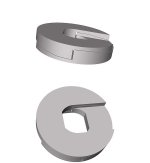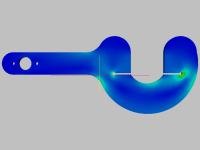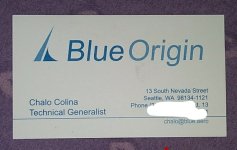Chalo said:I could get into more math and physics ...
Prove it! (ie. Put up, or shut up.)
Chalo said:I could get into more math and physics ...
amberwolf said:In my case, neither controller responds to any form of braking control other than on/off.Unfortunately most controllers are like that, and only some (though a growing number) can do proportional braking, where there is some method for a degree of control over how much braking force is applied.
amberwolf said:It does look a bit complex to manufacture;
amberwolf said:are each of the two parts in the diagram intended to be made from one piece of metal each, and then just the arm made of the spring layers?
fechter said:Anytime somebody starts bragging about how great they are, it's a red flag.
fechter said:What the members here have is a lot of practical experience, which I consider to be more important than math skills.
fechter said:Just some of your posts could be taken as personal attacks on other members, which is not allowed and doesn't help anything.
fechter said:It sounds like "I'm right and you're wrong because I have 40 years or experience", which is not a valid argument.
fechter said:Highly skilled and experienced engineers screw up all the time. That's why rockets explode.
fechter said:I only have 39 years of experience as an engineer and 9 issued US patents but I am always interested in peoples' real world experience.
amberwolf said:It does look a bit complex to manufacture; are each of the two parts in the diagram intended to be made from one piece of metal each, and then just the arm made of the spring layers?

DRMousseau said:The "multi-leaf" design would provide the flexibility "I" require in my needs, by using all that I can, even if only a few, in providing a margin of protection above none at all! I also feel that the design provides an added "locking" benefit that would conservatively replace the basic required lock-washers and serve multiple purposes in replacing those with an added "leaf" of torque "arrest" AND locking protection. Given it's simplicity, materials, and unique design qualities, I'd expect to find it economically available (or easily fabricated myself) AND a very viable AND RELIABLE alternative to consider for my purposes,.... that being under 2000w.
Buk___ said:Latest version is much simpler; with one reversible part providing both halves of the clamping action.
I think this shows how the two identical halves, fit around the axle and the ramped internal surfaces clamp onto the axle flats as the nut is done up to eliminate freeplay and adapt to different tolerances?
AWTA2-3d.jpg
I've still got nothing on the spring part, but I guess the design would work worth a solid arm if you are unconvinced by the benefits of that. It could even be adapted to Justin's behind the chainstay design.
amberwolf said:It looks simpler, Im still imagining how it might be manufactured in a way I could do here, but I think I *might* be able to by hand, though ti would require fitting and filing till they matched each other. Not a mass production method, but something I could at least test on one wheel, and see if it does whats intended. If so, others could use them too.
Id like to see what the spring arm would do, myself. Its not a design anyone has tried yet, so its certainly worth exploring. Im still at the stage of understanding the concept and basics
amberwolf said:A bit OT, but if its useful, some further input on my regen braking: I took a coworker home tonight and he probably weighs at least what I do (hes taller but skinnier), around 180lbs, so add that to the trikes normal mass. On the way to his place I had to take the underpass below the freeway, which is a fairly long steep downhill (for Phoenix); I dont know what hte grade is though. Anyway, I used the electric braking to slow down starting around halfway down, and it took the entire distance to slow nearly to a stop, and then used the mechanical front brake to finish up as I reached the crosswalk line.
The interesting part is that the current back to the battery more than doubled, to -18A (where its usually around -6 to -8A). Meaning the regen side controller was able to produce that much more current than it usually does, compared to the current required to drive the active braking (EABS) on the other side (which I have no way as yet of determining the current it takes to do, without modifying something on the trike).
So Im assuming that the extra energy from the extra mass and/or slope caused greater force against the system keeping the current higher on regen for longer, so that at some point in the curves it was higher than the demand by the EABS so more got fed back into the battery by regen.
Alan B said:Wedge Locking washers like the NordLock must engage the two faces on either side to work. [...] so to release the nut takes more torque than for it to stay where it is,
Chalo said:Alan B said:Wedge Locking washers like the NordLock must engage the two faces on either side to work. [...] so to release the nut takes more torque than for it to stay where it is,
Nope. With or without a softer surface to bite into, they release at a lower torque than an ordinary flat washer.
[youtube]WbLS3rGtKDM[/youtube]
Alan B said:[Chalo apparently failed to watch the whole video. Wedge Lockwashers don't work by taking more tension to release. And they work vastly better than flat washers. Need to do your homework, and the whole assignment.
Alan B said:Chalo said:Alan B said:Wedge Locking washers like the NordLock must engage the two faces on either side to work. [...] so to release the nut takes more torque than for it to stay where it is,
Nope. With or without a softer surface to bite into, they release at a lower torque than an ordinary flat washer.
Chalo apparently failed to watch the whole video. Wedge Lockwashers don't work by taking more tension to release.
Chalo said:I think it's revealing that Buk has a conviction about Nord-locks that can't be dispelled even by instrumented tests.
Chalo said:Fastener torque and fastener tension/strain are related, but they are in no way the same thing.
The two partners are kept together by a combination of their threads' friction (with slight elastic deformation), a slight stretching of the bolt, and compression of the parts to be held together.
Chalo said:The torque arm at the top of the thread exhibits an analogous misunderstanding of stress and strain.
Chalo said:I don't have to demonstrate my credentials to you.



Buk___ said:Exactly as predicted (by me!) in both location and magnitude; and entirely within the proof stress of the material selected.
Buk___ said:200 N
No sh...ugar, Dad. (You cannot specify a torque, so you have to specify the force per unit area that would result from the torque acting on the face!)Chalo said:Buk___ said:200 N
That's not a torque, son.
Buk___ said:No sh...ugar, Dad. (You cannot specify a torque, so you have to specify the force per unit area that would result from the torque acting on the face!)Chalo said:Buk___ said:200 N
That's not a torque, son.
But that'll be over your head.

Chalo said:Buk___ said:200 N
That's not a torque, son.
